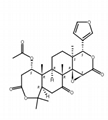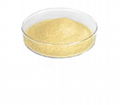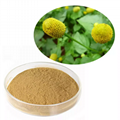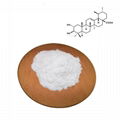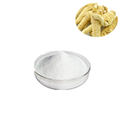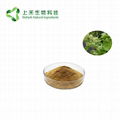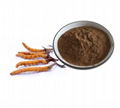| Model: | STA-200 |
|---|---|
| Brand: | STAHERB |
| Origin: | Made In China |
| Category: | Agriculture & Foods / Agricultural Products & Resources / Plant Extract |
| Label: | Green tea extract , EGCG , EGCG |
| Last Online:03 Apr, 2025 |
Product name: EGCG
Plant Origin: Camellia sinensis L.
Specification: EGCG 10% ~ 98%
Test mothed: UV/HPLC
Solubility: Soluble in water easily
Appearance: White to off-white fine powder
Sieze: 100% pass 80 mesh
Green tea is made from Camellia sinensis leaves that have not undergone the same withering and oxidation applied when processing Camellia sinensis into oolong tea and black tea.
Grean tea has been cultivated for centuries, beginning in China. Today, tea is the most widely-consumed beverage in the world, second only to water. Hundreds of millions of people drink tea, and studies s est that green tea (Camellia sinesis) in particular has many health benefits.
Green tea extract EGCG have been used in traditional Chinese and Indian medicine for a variety of uses.
Green tea extract powder is a herbal derivative from green tea leaves (Camellia sinensis). Containing antioxidant ingredients – mainly green tea catechins (GTC) – green tea and its derivatives are sometimes used as dietary supplements and in alternative medicine.
Tea Polyphenols found in green tea include epigallocatechin gallate (EGCG), epicatechin gallate, epicatechins and flavanols.
Function:
1. EGCG can reduce blood pressure, blood sugar, blood lipids.
2. EGCG has the function of removing radicals and anti-aging.
3. EGCG can enhance the immune function and prevention of colds.
4. EGCG has the function of anti-radiation, anti-cancer, inhibiting the increasing of cancer cell.
5. EGCG is used to anti-bacterium, with the function of sterilization and deodorization.
Application:
1. Applied in cosmetics field, Green tea extract EGCG owns the effect of anti-wrinkle and anti-Aging;
2. Applied in food field, Green tea extract EGCG is used as natural antioxidant, antistaling agent, and anti-fading agents;
3. Applied in pharmaceutical field, Green tea extract EGCG is used to prevent and cure cardiovascular disease, diabetes.
References:
Comparative effects of polyphenols from green tea (EGCG) and soybean (genistein) on VEGF and IL-8 release from normal human keratinocytes stimulated with the proinflammatory cytokine TNFα
In skin inflammation, vascular endothelial growth factor (VEGF) and IL-8 play an important role and are produced by activated keratinocytes. Recently, some polyphenols have been reported to exhibit antiinflamm...
Sandra Trompezinski, Alain Denis, Daniel Schmitt… in Archives of Dermatological Research (2003)
Synergistic enhancement of anticancer effects on numerous human cancer cell lines treated with the combination of EGCG, other green tea catechins, and anticancer compounds
In 2008, we reported that 10 Japanese-size cups of green tea daily, supplemented with tablets of green tea extract (GTE), reduced the recurrence of colorectal adenoma by 51.6 % in patients after polypectomy. B...
Hirota Fujiki, Eisaburo Sueoka… in Journal of Cancer Research and Clinical On… (2015)
Extraction behavior of caffeine and EGCG from green and black tea
A dipping method was developed to extract the catechins (EGCG) and alkaloids (caffeine) from green tea (Korea) and black tea (Sri Lanka). The effects of the ... solvent pH on the amount of catechins (EGCG) and al...
Kwang Jin Lee, Sang Hoon Lee in Biotechnology and Bioprocess Engineering (2008)
Diet supplementation with green tea extract epigallocatechin gallate prevents progression to glucose intolerance in db/db mice
Green tea was s ested as a therapeutic agent for ... , we address this issue by feeding a green tea extract (TEAVIGO™) with a high content of epigallocatechin gallate (EGCG) or the thiazolidinedione PPAR-γ agon...
Henrik Ortsäter, Nina Grankvist, Swen Wolfram, Nicolas Kuehn… in Nutrition & Metabolism (2012)
The specific anti-cancer activity of green tea (−)-epigallocatechin-3-gallate (EGCG)
The effect of the green tea polyphenol-(−)epigallocatechin-3-gallate (EGCG) was tested in cultures of normal and transformed NIH-pATMras fibroblasts. In this system transformation can be induced at will by the a...
Y.-C. Wang, U. Bachrach in Amino Acids (2002)
Biophysical characteristics of proteins and living cells exposed to the green tea polyphenol epigallocatechin-3-gallate (EGCg): review of recent advances from molecular mechanisms to nanomedicine and clinical trials
Herbs and traditional medicines have been applied for thousands of years, but researchers started to study their mode of action at the molecular, cellular and tissue levels only recently. Nowadays, just like i...
Beatrix Peter, Szilvia Bosze, Robert Horvath in European Biophysics Journal (2017)
Pharmacokinetics of the green tea derivative, EGCG, by the topical route of administration in mouse and human skin
Purpose: (−)-Epigallocatechin gallate (EGCG), the main physiologically active polyphenol of green tea, is associated with antitumor and antimutagenic activities. The goal of this study was to determine the stabi...
Katerina Dvorakova, Robert T. Dorr, Susanne Valcic… in Cancer Chemotherapy and Pharmacology (1999)
Gene regulation mediated by microRNAs in response to green tea polyphenol EGCG in mouse lung cancer
Epigallocatechin-3-gallate (EGCG) has been demonstrated to inhibit cancer in experimental studies through its antioxidant activity and modulations on cellular functions by binding specific proteins. We demonst...
Hong Zhou, Jayson X Chen, Chung S Yang, Mary Qu Yang, Youping Deng… in BMC Genomics (2014)
Green tea extract and its major constituent epigallocatechin-3-gallate inhibit growth and halitosis-related properties of Solobacterium moorei
Solobacterium moorei...is a volatile sulfide compound (VSC)-producing Gram-positive anaerobic bacterium that has been associated with halitosis. The aim of this study was to investigate the effects of green tea extract
Marie-Pierre Morin… in BMC Complementary and Alternative Medicine (2015)
Prodrug of green tea epigallocatechin-3-gallate (Pro-EGCG) as a potent anti-angiogenesis agent for endometriosis in mice
Green tea epigallocatechin-3-gallate (EGCG) can inhibit angiogenesis and development of an experimental endometriosis model in mice, but it suffers from poor bioavailability. A prodrug of EGCG (pro-EGCG, EGCG ...
Chi Chiu Wang, Hui Xu, Gene Chi Wai Man, Tao Zhang, Kai On Chu… in Angiogenesis (2013)
The Relation Assessment Between 50 Hz Electric Field Exposure-Induced Protein Carbonyl Levels and The Protective Effect of Green Tea Catechin (EGCG)
The aim of this study was to determine the oxidation of proteins, measuring the protein carbonyl levels (PCO) as biomarkers of oxidative stress, and to answer whether protective effect of green tea catechin, E...
Arin Tomruk, G. Güler, N. Seyhan in 11th Mediterranean Conference on Medical a… (2007)
Analysis of the effect of the active compound of green tea (EGCG) on the proliferation of peripheral blood mononuclear cells
Cancer immunotherapy requires proper manipulation of the immune system, lymphocytes in particular, in order to identify and destroy the cancer cells as non-self. In this study we investigated the effect of the...
Farid Saleh, Raj Raghupathy, Sami Asfar… in BMC Complementary and Alternative Medicine (2014)
EGCG, a major green tea catechin suppresses breast tumor angiogenesis and growth via inhibiting the activation of HIF-1α and NFκB, and VEGF expression
The role of EGCG, a major green tea catechin in breast cancer therapy is poorly understood. The present study tests the hypothesis that EGCG can inhibit the activation of HIF-1α and NFκB, and VEGF expression, ...
Jian-Wei Gu, Kristina L Makey, Kevan B Tucker, Edmund Chinchar… in Vascular Cell (2013)
Download PDF (876 KB) View Article
Biological significance of myeloperoxidase (MPO) on green tea component, (−)-epigallocatechin-3-gallate (EGCG)-induced apoptosis: its therapeutic potential for myeloid leukemia
The therapeutic approach to acute myeloid leukemia (AML) is usually chemotherapy, but severe side effects and complications induced by the anticancer drugs are sometimes fatal and are major problems in the cli...
Masahiro Kizaki in Targeted Oncology (2008)
Catechins play key role in green tea extract–induced postprandial hypoglycemic potential in vitro
Green tea is often associated with glycemic control benefit. ... , we systematically assessed the contribution of main green tea extract (GTE) ingredients to the inhibition of ... solution containing seven catech...
Ying Xu, Zhang Zhang, Lin Li, Manoj Kumar Joshi… in European Food Research and Technology (2013)
Green tea extract with polyethylene glycol-3350 reduces body weight and improves glucose tolerance in db/db and high-fat diet mice
Green tea extract (GTE) is regarded to be effective against obesity and type 2 diabetes, but definitive evidences have not been proven. Based on the assumption that the gallated catechins (GCs) in GTE attenuat...
Jae-Hyung Park, Yoon Jung Choi… in Naunyn-Schmiedeberg's Archives of Pharmaco… (2013)
Beneficial Effects of Green Tea Catechins on Neurological Disorders
Green tea is natural dried leaves of the tea plant, Camellia sinensis. This “nonfermented” tea contains more catechins than black tea (oxidized green tea) or oolong tea (partially oxidized tea). The composition o...
Akhlaq A. Farooqui in Phytochemicals, Signal Transduction, and Neurological Disorders (2012)
Pharmacological profile of green tea and its polyphenols: a review
Tea (Camellia sinensis, Theaceae) is the second most consumed beverages in the world, next to water in terms of worldwide popularity. The chemical components of green tea chiefly include polyphenols, caffeine, an...
Sumit Bansal, Navneet Syan, Pooja Mathur, Shivani Choudhary in Medicinal Chemistry Research (2012)
The green tea polyphenol EGCG potentiates the antiproliferative activity of sunitinib in human cancer cells
Sunitinib is a promising drug for clinical applications; however, the efficacy is reduced by the feedback activation of many signaling cascades. In this study, we investigated the ability of (−)-epigallocatech...
Yi Zhou, Jie Tang, Yang Du, Jing Ding, Ji-Yan Liu in Tumor Biology (2016)
Delayed Treatment with Green Tea Polyphenol EGCG Promotes Neurogenesis After Ischemic Stroke in Adult Mice
(−)-Epigallocatechin-3‑gallate (EGCG), the predominant constituent of green tea, has been demonstrated to be neuroprotective against acute ischemic stroke. However, the long-term actions of EGCG on neurogenesi...
Jian-Cheng Zhang, Hang Xu, Yin Yuan, Jia-Yi Chen, Yu-Jing Zhang… in Molecular Neurobiology (2017)
Company Introduction
Address: Room 202, Building B8, Huanchuang Enterprise Square, Lugu Street, Yuelu District, Changsha City, Hunan Province
Website: http://www.staherb.cn/
Business scope: Biotechnology, research and development of plant extracts (can be used in the field of pharmaceutical and health products, cosmetics, feed additives and biological pesticide production and development)
Main products: Eucommia extract - chlorogenic acid (5%-98%), ursolic acid (25%-98%), corosolic acid (1%-98%), bitter amygdalin (50%-98%), epimedoside (10%-98%) and other standardized high-purity plant extracts.
If you wanna know more about us, please feel free to contact me at:
Whatsapp: +86 18975842720
Email: sales12@staherb.cn
or you can send me online message if it's convenient for you.
We look forward to cooperating with you!
